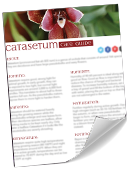Fertilizer: The Truth Behind the Numbers
Author: Melanie Dearringer1 Comment
Care and Culture, Product Reviews

We all know that orchids don’t grow in flower pots in the wild. They are placed there so that we may enjoy them in our homes and offices. And when we remove orchids from their natural growing environments and place them in these decorative containers, we block their ability to obtain all the essential nutrients required for optimal growth. Sure, your orchid will survive with optimal growing conditions, but fact is, a properly fed orchid is a healthier, happier, and more beautiful orchid.
Making Sense of the Numbers
Fertilizer plays an important role in maintaining your orchid. But before you run to the store to make a purchase and find yourself overwhelmed with the abundance of different options available, let’s dig a little deeper into the fundamentals of fertilizer. Each fertilizer product advertises three numbers on the front of its package. These numbers actually provide great understanding as to what the fertilizer will do.
The numbers refer to the percentage by weight of Nitrogen, Phosphorus, and Potassium (NPK – always listed in that order) within that particular fertilizer compound. A balanced fertilizer, such as a 20-20-20, is made up of equal parts of Nitrogen, Phosphorus, and Potassium each representing 20%. Anyone who is doing their math will undoubtedly realize that these numbers do not add up to 100%. This is because while fertilizers contain more than three nutrients, NPK are the only prominently displayed elements due to your plant’s need for them in a higher quantity.
 Now that you know what the numbers represent, how can you use this information to choose the right formula? First, it is important to know how these different nutrients affect your orchid. Nitrogen promotes growth in the parts of your plant that you can see above your potting mix, such as foliage. Phosphorus is responsible for the part of your orchid beneath the potting mix. It encourages healthy root systems and is responsible for beautiful flower blooms. And finally, Potassium is crucial for your orchid’s overall health. This important nutrient helps plants deal with the stresses associated with temperature, disease, and insects.
Now that you know what the numbers represent, how can you use this information to choose the right formula? First, it is important to know how these different nutrients affect your orchid. Nitrogen promotes growth in the parts of your plant that you can see above your potting mix, such as foliage. Phosphorus is responsible for the part of your orchid beneath the potting mix. It encourages healthy root systems and is responsible for beautiful flower blooms. And finally, Potassium is crucial for your orchid’s overall health. This important nutrient helps plants deal with the stresses associated with temperature, disease, and insects.
Additional Nutritional Needs
Aside from Nitrogen, Phosphorus, and Potassium, healthy orchids require 13 other nutrients. They are categorized as either macronutrients or micronutrients. Elements identified as macronutrients are needed in larger quantities while micronutrients, also known as trace elements, are only needed in small doses.
Macronutrients
- Calcium
- Carbon
- Hydrogen
- Magnesium
- Nitrogen
- Oxygen
- Phosphorus
- Potassium
- Sulfur
Micronutrients or Trace Elements
- Boron
- Chlorine
- Copper
- Iron
- Manganese
- Molybdenum
- Zinc
This is a seemingly long list of nutrients that you should make sure your fertilizer includes. Luckily carbon, hydrogen, and oxygen are supplied through air and water and are not needed in a fertilizer. Furthermore, most trace elements are not included in fertilizer because they are found in both potting mix and water leaving most orchid food consisting of calcium, magnesium, nitrogen, phosphorus, potassium, and sulfur. It is worth noting that if you are using reverse osmosis or rain water when watering your orchid, you will need to find a fertilizer that contains the micronutrients as as well.
Orchid Fertilizer vs Plant Fertilizer
Is there a difference? Not really. Plant fertilizer, like orchid fertilizer, comes in a variety of formulas. Just be sure to check the labels for nutrient contents and percentages. Because most orchids are epiphytes growing in the wild on trees and obtaining nutrients from the passing air and rain or through debris accumulation, mineral absorption happens rapidly and in small quantities. This is quite different than terrestrial plants that have their roots in nutrient-rich soil. Since terrestrial plants are more accustom to higher quantities of nutrients, instructions on regular plant fertilizer will tell you to use a higher concentration than is recommended for orchids. These fertilizers should be used at half or even quarter strength.
Suggestions
Most growers suggest using a balanced formula containing little or no urea. Urea is a form of nitrogen that is common among regular plant fertilizers. Urea nitrogen works great for plants that have their roots in soil. But since we learned that most orchids are epiphytes, it is recommended to use a fertilizer that provides nitrogren in the form of nitrates. Urea free formulas will be easily identifiable by their packaging.
Click here to access our FREE Guide to Orchid Fertilizer for quick information and helpful tips.
Sources
Orchid Fertilizer
The Numbers on Fertilizer Labels, What They Mean
Fertilizing Orchids
One response on “Fertilizer: The Truth Behind the Numbers”
Leave a Reply


Ask an Expert
Questions about orchids?
Our experts love a challenge!
Photo of the Week
Submit your photo to be featured on the blog!
More Photo of the Week Winners
Submit Photo








Hi, can I fertilize my orchid during spike growth?